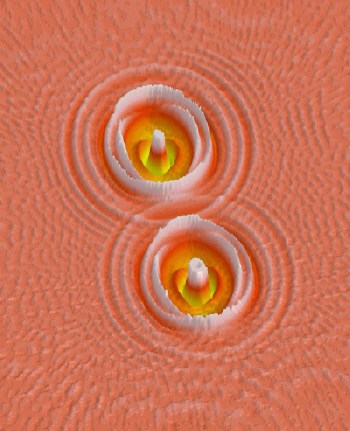Physicists in the US have shown that two nano-scale magnets can be made to oscillate in phase when they are positioned close to one another. The phenomenon, which is similar to the way two pendulum clocks mounted on the same wall become synchronized via the weak coupling of acoustic signals, produces a stable microwave output. It could therefore replace bulky and expensive components which operate on the same "phase-locking" principle in devices such as portable phones and radar systems. The magnets may also serve as tiny receivers that would enable microchips to communicate with each other without being in contact, dramatically increasing the processing power of computers (Nature 437 389 & 393).

Shehzaad Kaka and colleagues at the National Institute of Standards and Technology (NIST) in Boulder and Fred Mancoff and co-workers of Freescale Semiconductor Inc. in Arizona built their nanomagnets from two magnetic films of different thicknesses separated by a non-magnetic layer. The layers were patterned using standard semiconductor processing technology, allowing the teams to produce magnets less than 100-nm across. The NIST device, for example, consists of circular devices with a diameter of 50 nanometers (see figure).
When a DC current is applied to such a device, the magnetic nature of the layers causes the intrinsic angular momentum or spin of electrons in the current to point in the same direction. In the NIST device this spin-polarized current induces a “spin torque”, which causes the direction of magnetization in the device to switch back and forth. In the Freescale device, the spin of the electrons in the current is transferred from the first film to the second, again causing its magnetization to oscillate.
These oscillations generate microwaves that can be tuned from a few gigahertz to several tens of gigahertz by simply varying the current or by applying an external magnetic field. Moreover, when two nanomagnets are placed close together (about 500-nm in the case of the NIST and 200-nm for the Freescale device) and certain combinations of currents are applied, they oscillate in harmony. This phase-locked system produces a microwave signal twice as intense as that generated by a single magnet, which was a key experimental signature of the effect.
Both teams say that phase-locking should occur in arrays containing more than two oscillating nanomagnets. An individual oscillator produces a 10 nanowatt signal, but small arrays of 10 nano-oscillators could produce more than 1 microwatt. Furthermore, the radiation produced is highly directional, making such arrays potentially useful in wireless transmitters and receivers. The researchers now plan to determine the mechanism behind the oscillations in more detail.



